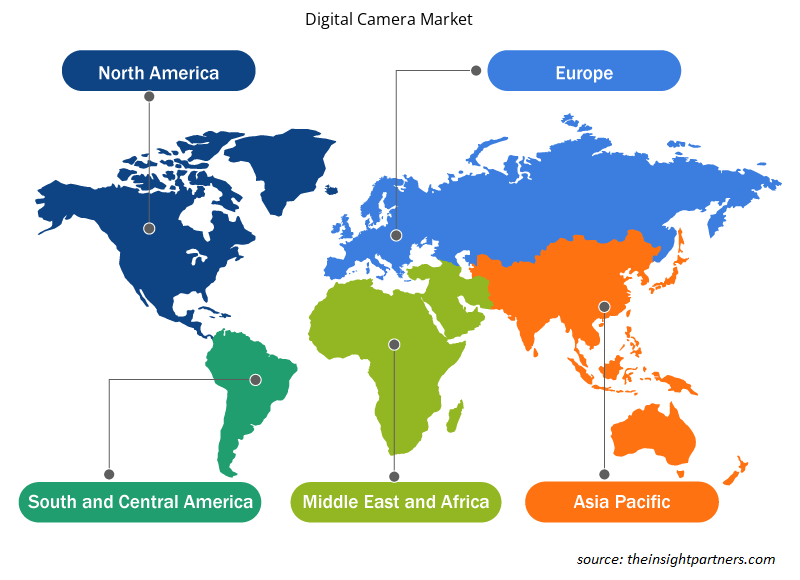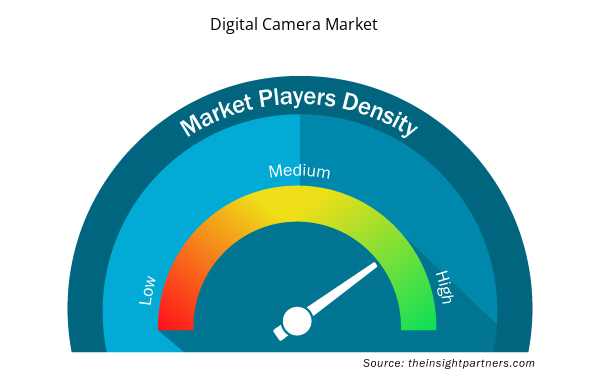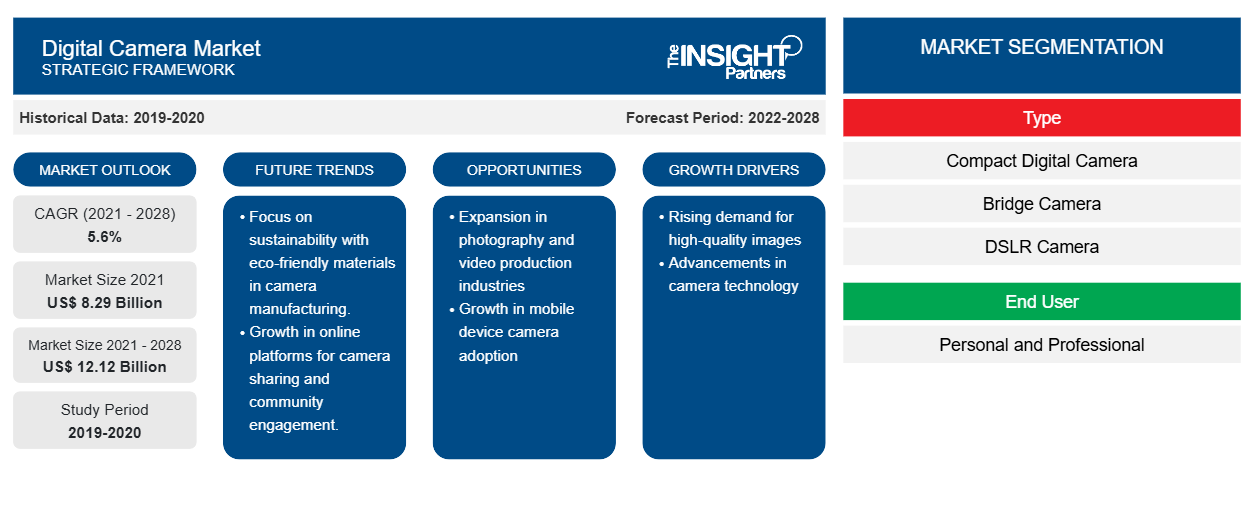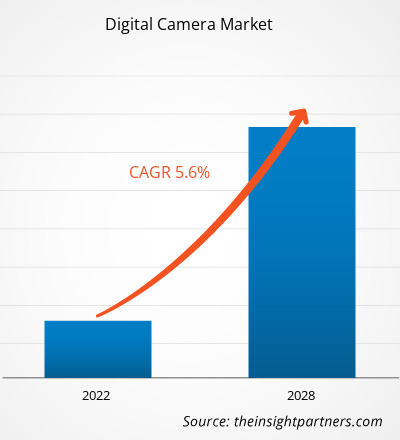Se espera que el mercado de cámaras digitales crezca de US$ 8.290,25 millones en 2021 a US$ 12.119,44 millones en 2028; se estima que crecerá a una CAGR del 5,6% durante 2021-2028.
El uso de cámaras digitales no se ha limitado únicamente a la fotografía personal y profesional, sino que se ha extendido a las industrias del entretenimiento, los medios de comunicación y los deportes. La industria cinematográfica es una de las categorías más grandes y lucrativas de la industria del entretenimiento global. Por ejemplo, la industria cinematográfica de China es una de las más grandes del mundo, con unos ingresos de unos 6.600 millones de dólares en 2016. Se espera que esta perspectiva prometedora de la industria cinematográfica y del entretenimiento impulse la demanda de cámaras digitales para lograr tomas y vídeos perfectos. Los rápidos cambios tecnológicos, el comportamiento del consumidor y los modelos de negocio han cambiado la forma en que los consumidores quieren experimentar y pagar por el entretenimiento y los medios de comunicación. Los líderes de esta industria se están concentrando en crear empresas y marcas centradas en los aficionados para producir contenido excepcional. Como resultado, invierten una cantidad significativa en tecnologías y equipos como imágenes generadas por ordenador (CGI) y efectos visuales (VFX), así como cámaras avanzadas.
Además, existe un uso indispensable de cámaras digitales en los medios deportivos. La instalación de cámaras digitales y de alta velocidad en los estadios permite a los espectadores ver repeticiones en cámara lenta de situaciones críticas del juego y ayuda a obtener precisión mientras miran. De manera similar, el uso de cámaras digitales de alta resolución en la fotografía de vida silvestre, paisajes, arquitectura y estudio ayuda a obtener imágenes y videos nítidos y definidos. El creciente interés por la fotografía de acción ha promovido posteriormente la demanda de cámaras digitales compactas, como GoPro. Además, las plataformas de redes sociales, como Instagram, han ampliado sustancialmente el alcance de la fotografía, lo que, a su vez, se espera que prolifere el crecimiento del mercado de las cámaras digitales.
Personalice este informe según sus necesidades
Obtendrá personalización en cualquier informe, sin cargo, incluidas partes de este informe o análisis a nivel de país, paquete de datos de Excel, así como también grandes ofertas y descuentos para empresas emergentes y universidades.
- Obtenga las principales tendencias clave del mercado de este informe.Esta muestra GRATUITA incluirá análisis de datos, desde tendencias del mercado hasta estimaciones y pronósticos.
Impacto de la pandemia de COVID-19 en el mercado europeo de cámaras digitales:
La pandemia del coronavirus ha afectado a las economías e industrias en varios países debido a los cierres, prohibiciones de viaje y cierres de negocios. La industria de la electrónica de consumo es una de las principales industrias que sufre graves interrupciones, como interrupciones de la cadena de suministro, cierres de plantas de producción, etc., debido a esta pandemia. El cierre de varias plantas de fabricación y fábricas en regiones líderes como América del Norte, Europa, Asia Pacífico, América del Sur, Oriente Medio y África ha afectado a la cadena de suministro global y ha impactado negativamente en la fabricación, los cronogramas de entrega y las ventas de varios bienes. Además, varias empresas ya han anunciado posibles retrasos en las entregas de productos y una caída en las ventas futuras de sus productos. Además de esto, las prohibiciones de viaje globales impuestas por países de Europa, Asia y América del Norte están afectando las oportunidades de colaboración y asociación comerciales. Se anticipa que todos estos factores afectarán a la industria de la electrónica de consumo de manera negativa y, por lo tanto, actuarán como factor restrictivo para el crecimiento de varios mercados relacionados con esta industria en los próximos meses. El mercado de cámaras digitales se ve afectado por la pandemia debido al déficit de producción junto con las limitadas instalaciones de transporte.
Perspectivas del mercado de cámaras digitales
Las innovaciones tecnológicas asociadas a las cámaras digitales impulsarán el crecimiento del mercado de cámaras digitales
El marco del mercado de las cámaras digitales está estrechamente asociado con las tendencias radicales emergentes respaldadas por desarrollos tecnológicos innovadores y avances robustos, como la alta definición y la pantalla táctil. Desde hace mucho tiempo, el mercado ha observado una mayor demanda de cámaras réflex digitales de un solo objetivo y cámaras SLR debido a la creciente inclinación de los consumidores hacia la fotografía avanzada. Sin embargo, el avance de la tecnología ha dado como resultado la creación de cámaras de alta resolución, que proporcionan entre 12 y 20 megapíxeles. La evolución continua en el campo de las cámaras digitales ha dado como resultado el diseño de cámaras avanzadas con mejor resolución, enfoque más rápido y soporte para diferentes periféricos. Además, también se ha observado un aumento en la tendencia a incorporar un módem Wi-Fi o 4G en las cámaras digitales para proporcionar una ventaja competitiva sobre los teléfonos inteligentes. Además, se prevé que dichas cámaras formen parte de varios dispositivos interconectados, como IoT (Internet de las cosas), lo que podría facilitar la comunicación efectiva con otros dispositivos interconectados, como teléfonos inteligentes y asistentes de altavoz en el futuro cercano.
Perspectivas del mercado basadas en tipos
Según el tipo, el mercado de cámaras digitales se clasifica en cámaras digitales compactas, cámaras bridge, cámaras DSLR, cámaras sin espejo, cámaras con telémetro digital y cámaras con escaneo lineal. En 2020, el segmento de cámaras DSLR representó la mayor participación en el mercado.
Perspectivas regionales del mercado de cámaras digitales
Los analistas de Insight Partners explicaron en detalle las tendencias y los factores regionales que influyen en el mercado de cámaras digitales durante el período de pronóstico. Esta sección también analiza los segmentos y la geografía del mercado de cámaras digitales en América del Norte, Europa, Asia Pacífico, Oriente Medio y África, y América del Sur y Central.

- Obtenga datos regionales específicos para el mercado de cámaras digitales
Alcance del informe sobre el mercado de cámaras digitales
| Atributo del informe | Detalles |
|---|---|
| Tamaño del mercado en 2021 | US$ 8,29 mil millones |
| Tamaño del mercado en 2028 | US$ 12,12 mil millones |
| CAGR global (2021-2028) | 5,6% |
| Datos históricos | 2019-2020 |
| Período de pronóstico | 2022-2028 |
| Segmentos cubiertos | Por tipo
|
| Regiones y países cubiertos | América del norte
|
| Líderes del mercado y perfiles de empresas clave |
|
Densidad de actores del mercado: comprensión de su impacto en la dinámica empresarial
El mercado de cámaras digitales está creciendo rápidamente, impulsado por la creciente demanda de los usuarios finales debido a factores como la evolución de las preferencias de los consumidores, los avances tecnológicos y una mayor conciencia de los beneficios del producto. A medida que aumenta la demanda, las empresas amplían sus ofertas, innovan para satisfacer las necesidades de los consumidores y aprovechan las tendencias emergentes, lo que impulsa aún más el crecimiento del mercado.
La densidad de actores del mercado se refiere a la distribución de las empresas o firmas que operan dentro de un mercado o industria en particular. Indica cuántos competidores (actores del mercado) están presentes en un espacio de mercado determinado en relación con su tamaño o valor total de mercado.
Las principales empresas que operan en el mercado de cámaras digitales son:
- Canon Inc.
- Compañía Eastman Kodak (JK Imaging Ltd.)
- Corporación Fujifilm Holdings
- Cámara Leica Ag
- Corporación Nikon
Descargo de responsabilidad : Las empresas enumeradas anteriormente no están clasificadas en ningún orden particular.

- Obtenga una descripción general de los principales actores clave del mercado de cámaras digitales
Información del mercado basada en el usuario final
Según la aplicación, el mercado de cámaras digitales se segmenta en personal y profesional. En 2020, el segmento profesional representó una mayor participación de mercado.
Los actores que operan en el mercado digital adoptan estrategias como fusiones, adquisiciones e iniciativas de mercado para mantener sus posiciones en el mercado. A continuación, se enumeran algunos de los principales actores:
- FUJIFILM Holdings Corporation anunció el lanzamiento de FUJIFILM GFX100S a fines de febrero de 2021. La cámara es la última incorporación a la serie GFX de cámaras digitales sin espejo.
- Nikon Corporation ha lanzado la cámara sin espejo de fotograma completo Z 7II. La Z 7II es una cámara sin espejo de fotograma completo y alta resolución. A través de este tipo de lanzamientos de productos, la empresa contribuye al desarrollo de la cultura de la imagen.
El mercado de cámaras digitales se ha segmentado de la siguiente manera:
Por tipo
- Cámara digital compacta
- Cámara puente
- Cámara DSLR
- Cámara sin espejo
- Cámara con telémetro digital
- Cámara de escaneo lineal
Por el usuario final
- Personal
- Profesional
Por geografía
América del norte
- A NOSOTROS
- Canadá
- México
Europa
- Francia
- Alemania
- Italia
- Reino Unido
- Rusia
- Resto de Europa
Asia Pacífico (APAC)
- Porcelana
- India
- Corea del Sur
- Japón
- Australia
- Resto de APAC
Oriente Medio y África (MEA)
- Sudáfrica
- Arabia Saudita
- Emiratos Árabes Unidos
- Resto de MEA
América del Sur (SAM)
- Brasil
- Argentina
- Resto de SAM
Perfiles de empresas
- Canon Inc.
- Compañía Eastman Kodak
- Corporación Fujifilm Holdings
- Cámara Leica Ag
- Corporación Nikon
- Acerca de la Corporación de Soluciones Digitales
- Corporación Panasonic
- Hasselblad
- Compañía de imágenes Ricoh, Ltd.
- Corporación Sony
- Análisis histórico (2 años), año base, pronóstico (7 años) con CAGR
- Análisis PEST y FODA
- Tamaño del mercado Valor/volumen: global, regional, nacional
- Industria y panorama competitivo
- Conjunto de datos de Excel



Report Coverage
Revenue forecast, Company Analysis, Industry landscape, Growth factors, and Trends

Segment Covered
This text is related
to segments covered.

Regional Scope
North America, Europe, Asia Pacific, Middle East & Africa, South & Central America

Country Scope
This text is related
to country scope.
Preguntas frecuentes
DSLR cameras held the largest share in 2020 and they are the most versatile, high-end, and advanced type cameras. These cameras use single-lens reflex method. They consist of a mirror, which reflects the light passing through the lens. DSLR cameras are mostly large in size. These cameras are mainly used by professional photographers or videographers for commercial purposes. Automatic mode and changeable camera lens to fit different situations are the important feature of DSLR cameras. However, DSLR camera manufacturers are now focusing on integrating software enhancements and other technologies in these cameras for enhanced consumer experience, this factor is expected to drive the demand in the coming years.
With the growing trend toward photography, the demand for digital cameras is expanding. Digital camera allows to capture and store photos and videos digitally rather than printing it to film as per traditional analog cameras. As the consumers are becoming enthusiastic toward sight capturing, the demand for compact, lightweight, and high-quality cameras is rising. Further, the introduction of digital cameras and smartphones has created photography a mainstream profession, which have subsequently generated the need for high quality cameras with user-friendly interface and affordable price.
Mirrorless cameras are expected to drive the future growth of digital camera market. A mirrorless system camera does not involve a mirror box within its body and are designed with a compact and attractive exterior with an electronic viewfinder paired with interchangeable lens. Such cameras offer convenience in use compared to digital SLR cameras owing to their smaller and lighter structure. Mirrorless camera comprises lens at the front body along with sensor placed inside and a screen along with an optional viewfinder placed at the back. Additionally, such cameras have small, short, and light lenses and are constructed with a tiny LED or OLED screen, which helps to deliver best possible results altogether. Hence, the expanding demand for mirrorless cameras is expected to create lucrative opportunities for the growth of the digital cameras market.
Trends and growth analysis reports related to Electronics and Semiconductor : READ MORE..
The List of Companies - Digital Camera Market
- Canon Inc.
- Eastman Kodak Company (JK Imaging Ltd.)
- Fujifilm Holdings Corporation
- Leica Camera Ag
- Nikon Corporation
- Om Digital Solutions Corporation
- Panasonic Corporation
- Hasselblad
- Ricoh Imaging Company, Ltd
- Sony Corporation
The Insight Partners performs research in 4 major stages: Data Collection & Secondary Research, Primary Research, Data Analysis and Data Triangulation & Final Review.
- Data Collection and Secondary Research:
As a market research and consulting firm operating from a decade, we have published and advised several client across the globe. First step for any study will start with an assessment of currently available data and insights from existing reports. Further, historical and current market information is collected from Investor Presentations, Annual Reports, SEC Filings, etc., and other information related to company’s performance and market positioning are gathered from Paid Databases (Factiva, Hoovers, and Reuters) and various other publications available in public domain.
Several associations trade associates, technical forums, institutes, societies and organization are accessed to gain technical as well as market related insights through their publications such as research papers, blogs and press releases related to the studies are referred to get cues about the market. Further, white papers, journals, magazines, and other news articles published in last 3 years are scrutinized and analyzed to understand the current market trends.
- Primary Research:
The primarily interview analysis comprise of data obtained from industry participants interview and answers to survey questions gathered by in-house primary team.
For primary research, interviews are conducted with industry experts/CEOs/Marketing Managers/VPs/Subject Matter Experts from both demand and supply side to get a 360-degree view of the market. The primary team conducts several interviews based on the complexity of the markets to understand the various market trends and dynamics which makes research more credible and precise.
A typical research interview fulfils the following functions:
- Provides first-hand information on the market size, market trends, growth trends, competitive landscape, and outlook
- Validates and strengthens in-house secondary research findings
- Develops the analysis team’s expertise and market understanding
Primary research involves email interactions and telephone interviews for each market, category, segment, and sub-segment across geographies. The participants who typically take part in such a process include, but are not limited to:
- Industry participants: VPs, business development managers, market intelligence managers and national sales managers
- Outside experts: Valuation experts, research analysts and key opinion leaders specializing in the electronics and semiconductor industry.
Below is the breakup of our primary respondents by company, designation, and region:

Once we receive the confirmation from primary research sources or primary respondents, we finalize the base year market estimation and forecast the data as per the macroeconomic and microeconomic factors assessed during data collection.
- Data Analysis:
Once data is validated through both secondary as well as primary respondents, we finalize the market estimations by hypothesis formulation and factor analysis at regional and country level.
- Macro-Economic Factor Analysis:
We analyse macroeconomic indicators such the gross domestic product (GDP), increase in the demand for goods and services across industries, technological advancement, regional economic growth, governmental policies, the influence of COVID-19, PEST analysis, and other aspects. This analysis aids in setting benchmarks for various nations/regions and approximating market splits. Additionally, the general trend of the aforementioned components aid in determining the market's development possibilities.
- Country Level Data:
Various factors that are especially aligned to the country are taken into account to determine the market size for a certain area and country, including the presence of vendors, such as headquarters and offices, the country's GDP, demand patterns, and industry growth. To comprehend the market dynamics for the nation, a number of growth variables, inhibitors, application areas, and current market trends are researched. The aforementioned elements aid in determining the country's overall market's growth potential.
- Company Profile:
The “Table of Contents” is formulated by listing and analyzing more than 25 - 30 companies operating in the market ecosystem across geographies. However, we profile only 10 companies as a standard practice in our syndicate reports. These 10 companies comprise leading, emerging, and regional players. Nonetheless, our analysis is not restricted to the 10 listed companies, we also analyze other companies present in the market to develop a holistic view and understand the prevailing trends. The “Company Profiles” section in the report covers key facts, business description, products & services, financial information, SWOT analysis, and key developments. The financial information presented is extracted from the annual reports and official documents of the publicly listed companies. Upon collecting the information for the sections of respective companies, we verify them via various primary sources and then compile the data in respective company profiles. The company level information helps us in deriving the base number as well as in forecasting the market size.
- Developing Base Number:
Aggregation of sales statistics (2020-2022) and macro-economic factor, and other secondary and primary research insights are utilized to arrive at base number and related market shares for 2022. The data gaps are identified in this step and relevant market data is analyzed, collected from paid primary interviews or databases. On finalizing the base year market size, forecasts are developed on the basis of macro-economic, industry and market growth factors and company level analysis.
- Data Triangulation and Final Review:
The market findings and base year market size calculations are validated from supply as well as demand side. Demand side validations are based on macro-economic factor analysis and benchmarks for respective regions and countries. In case of supply side validations, revenues of major companies are estimated (in case not available) based on industry benchmark, approximate number of employees, product portfolio, and primary interviews revenues are gathered. Further revenue from target product/service segment is assessed to avoid overshooting of market statistics. In case of heavy deviations between supply and demand side values, all thes steps are repeated to achieve synchronization.
We follow an iterative model, wherein we share our research findings with Subject Matter Experts (SME’s) and Key Opinion Leaders (KOLs) until consensus view of the market is not formulated – this model negates any drastic deviation in the opinions of experts. Only validated and universally acceptable research findings are quoted in our reports.
We have important check points that we use to validate our research findings – which we call – data triangulation, where we validate the information, we generate from secondary sources with primary interviews and then we re-validate with our internal data bases and Subject matter experts. This comprehensive model enables us to deliver high quality, reliable data in shortest possible time.


 Obtenga una muestra gratuita de este informe
Obtenga una muestra gratuita de este informe